MANNY GUITERREZ LOOKS dour as he stares down his camera set up in his parents’ house.
Dressed in a grey hoodie and makeup free – unusual, for someone who’s entire career is based around makeup – Manny speaks solemnly about his “reality check”.
Can’t see the video? Click here.
“This has been a huge life lesson to me,” he says to the camera. “At the end of the day, I need to take responsibility for my actions and the things that I do and for the human that I am.”
What warranted such an admission? Well, for a multitude of reasons. However, this article breaks it down best.
A litany of controversies continues to plague members of the once impenetrable beauty community. Questions of authenticity arose from bullying and racism allegations.
… Which prompted Makeup Geek CEO, Marlena Stell to make a video concerning “her truth” about the beauty industry.
Can’t see the video? Click here.
Marlena had some serious revelations about her brand, saying that Makeup Geek has struggled to keep up in the new age of influencer marketing. She claims that her brand has suffered because influencers are reluctant to support it – unless they’re paid a large fee.
“When you’re a smaller company, you don’t have the big funds to do that especially if we’re trying to make makeup in the US.
We don’t have $60,000 to pay someone to do one video, and that’s the rates that we’ve been given.”
“As an influencer, I want to support other influencers so much because I know what it’s like [...] It’s hard. It’s difficult to be an influencer and putting yourself out there publicly.
“However, there’s a difference between making a good living for yourself and charging so much that there comes a sense of entitlement,” she continues.
Although Marlena did not disclose the specific influencer who quoted her $60,000 for a video, a few names were bandied around – Manny, as previously mentioned and James Charles.
At the time of writing, James has just 8.8 million subscribers on YouTube, and roughly the same amount of followers on Instagram, at just 19 years old.
James felt it was “irresponsible” of her to mention that figure when speaking about how much make per sponsored video or post, saying it created a “witch hunt” against influencers. (Marlena has since announced she’s working with Netflix on a documentary about the beauty industry, slated for release in 2019.)
However, there’s been plenty of other scathing videos on the internet concerning the industry. Brands pulling negative reviews off the internet, brands influencers to give negative reviews to rival products … The list goes on.
How did we get here, though?
When did brands stop looking to traditional media to advertise their wares, opting to shill glossy PR packages to the Insta famous or sponsor their haul videos instead?
David White works as a Senior Talent Manager at a leading influencer management agency in New York. In a recent YouTube video, he breaks down how influencers have evolved in to stand-alone brands.
“Influencing has been around way before social media. Traditionally, it was journalists and celebrities that were influential figures. However, social media has really allowed the normal, average person to become an influencer simply based on their point of passion.”
It’s much more accessible to have influence now than it was 10 – 15 years ago.”
So, while you may not have witnessed someone unboxing a PR package on Instagram ten years ago, rest assured they were still getting them behind the scenes.
The attention economy
“It all comes down to attention and understanding where your targeted consumers attention is,” Dave Alton, marketing lecturer at UCC, tells DailyEdge.ie.
“As a generalisation, for many brands the desired consumer of their product is young, urban, and affluent. These consumers don’t read newspapers, and don’t watch TV in the traditional sense. Rather, they seek out what content interests them, often spontaneously, via Netflix, Spotify, YouTube, Instagram, streaming platforms etc.
“Even live TV, such as sports events, aren’t consumed as ad supported media anymore. Rather, companies like Amazon Prime and Eleven Sports are starting to buy the rights to specific sporting events, and consumers are willing to pay a subscription to avoid ads which don’t interest them or interfere with their viewing experience.
The attention economy means that marketing communications must be focused on attracting consumer “eyeballs” and maintaining consumer engagement.
“In this regard, if a consumers is actively following an influencer’s vlogs for example, it is easier for brands to circumvent traditional media channels, instead opting to promote their product where the consumers attention already resides.”
He explains that it’s also just celebrity endorsement 101 – while you might not know James Charles, for example, plenty of others do, and consider themselves fans of his content.
“We associate a brand with the specific characteristics of a celebrity – Nike’s partnership with Colin Kaepernick as a means of targeting consumers who support perceptually ‘progressive’ brands would be a recent example.”
Influencer marketing also incorporates a “word of mouth” element. For example, if you see your favourite Instagrammer showing off a dress they just bought that you like, you’re more likely to respond to that than a traditional magazine ad. (It’s also why people tend to be less receptive to influencers #sponcon).
Money talks, but it also ‘grams’
Influencers make money through a variety of means – straight up sponsored content, in which influencers are paid for their content, be it to promote a product or a service. Then, there’s affiliate programmes, in which brands pay influencers based off of the number of sales that they generate, be it through their content or their influence.
“If we take Instagram as one of the primary platforms where influencer marketing is deemed to be at its most effective, the amount of ‘influencer’ based posts has more than doubled,” Alton says.
The size of the US influencer market is estimated to be about $2 billion, but again, the trend is upwards, with some economists and commentators suggesting it could reach close to $10 billion by 2020, though this is a largely estimated, and I would say over-exaggerated figure.”
How much brands pay for influencers varies – someone with 500 followers could be deemed a micro social influencer, provided that they are promoting (inadvertently or not) some form of product, service, community, experience, or brand. However, they’re probably not going to charge the same rates as someone with a couple of hundred thousand followers under their belt.
A brand manager, who wished to remain anonymous, showed DailyEdge.ie rate card provided to them by an international agency which represents influencers. A campaign where the aim is to increase a brand or product’s reach can cost as much as €8,000 for a single Instagram post and story from up to 20 influencers.
I think the authenticity thing is over done; and is often contradicted by the brands the influencer will work with after e.g McDonalds after doing a fitness campaign.
“It can be hard to prove a return on them and for some others in similar position they don’t think the return on investment is great,” the source tells DailyEdge.ie
“Some elements of the industry is bandit country and some are pretty professional, I think influencer agents are unnecessary and just add a layer that contributes an unnecessary layer of communication. One agent had so much back and forth with ‘the client doesn’t want to do this, client would prefer this’ that they just lost our business in the end.
I have found some influencers to be pretty unreliable but the ones that can be relied upon, that don’t overdo it with the brands they work with and are straight forward to deal with will make a lot of money.”
It’s often been argued that brands are only interested in follower numbers rather than engagement, which encourages the practice of follower buying. However, the source said this is not the case for their particular company, where each influencer’s engagement rate is assessed before approaching them for collaborations.
The end is nigh?
While White reckons the industry looks only set to increase rather than die down, Alton reckons a negative reaction to this growth can be expected from consumers.
The main issue here is the amount of misinformation, or more accurately, incomplete information that now exists online. If we take a singular employee review on Glassdoor, a product review, and a review on TripAdvisor… We as consumers are unaware of the context within which a piece of content is written – was the employee in the wrong and disgruntled when they left the review; is the product review by someone being paid to endorse said product; is the review on TripAdvisor from a competitor hotel brand?”
“When operating with incomplete information I think it’s important that consumers seek out multiple sources before making decisions – of course, basic consumer psychology suggests that we as consumers are irrational, and make a myriad of decisions based on emotion rather than logic.”
The anonymous source also reckons influencers are here to stay, as brands and marketing managers continue to try and circumnavigate ad blockers.









COMMENTS